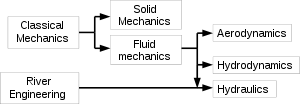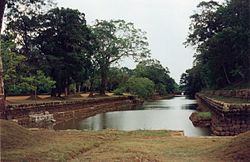- Hydraulics
-
For the United States Navy ship, see USS Hydraulic (SP-2584).
Hydraulics is a topic in applied science and engineering dealing with the mechanical properties of liquids. Fluid mechanics provides the theoretical foundation for hydraulics, which focuses on the engineering uses of fluid properties. In fluid power, hydraulics is used for the generation, control, and transmission of power by the use of pressurized liquids. Hydraulic topics range through most science and engineering disciplines, and cover concepts such as pipe flow, dam design, fluidics and fluid control circuitry, pumps, turbines, hydropower, computational fluid dynamics, flow measurement, river channel behavior and erosion.
Free surface hydraulics is the branch of hydraulics dealing with free surface flow, such as occurring in rivers, canals, lakes, estuaries and seas. Its sub-field open channel flow studies the flow in open channels.
The word "hydraulics" originates from the Greek word ὑδραυλικός (hydraulikos) which in turn originates from ὕδωρ (hydor, Greek for water) and αὐλός (aulos, meaning pipe).
Contents
Ancient and medieval era
Early uses of water power date back to Mesopotamia and ancient Egypt, where irrigation has been used since the 6th millennium BC[citation needed] and water clocks had been used since the early 2nd millennium BC[citation needed]. Other early examples of water power include the Qanat system in ancient Persia[citation needed] and the Turpan water system in ancient China[citation needed].
Greek / Hellenistic world
Greeks continued and sophisticated the construction of water and hydraulic power systems. An example is the construction by Eupalinos, under a public contract, of a watering channel for Samos[citation needed]. An early example of the usage of hydraulic wheel, probably the earliest in Europe, is the Perachora wheel (3rd c. BC).[2]
Notable is the construction of the first hydraulic automata by Ctesibius (flourished c. 270 BC)[citation needed] and Hero of Alexandria (c. 10–80 AD)[citation needed]. Hero describes a number of working machines using hydraulic power[citation needed], such as the force pump, which is known from many Roman sites as having been used for raising water and in fire engines[citation needed].
China
In ancient China there was Sunshu Ao (6th century BC), Ximen Bao (5th century BC), Du Shi (circa 31 AD), Zhang Heng (78 - 139 AD), and Ma Jun (200 - 265 AD), while medieval China had Su Song (1020 - 1101 AD) and Shen Kuo (1031–1095)[citation needed]. Du Shi employed a waterwheel to power the bellows of a blast furnace producing cast iron[citation needed]. Zhang Heng was the first to employ hydraulics to provide motive power in rotating an armillary sphere for astronomical observation[citation needed].
Sri Lanka
In ancient Sri Lanka, hydraulics were widely used in the ancient kingdoms of Anuradhapura and Polonnaruwa.[3] The discovery of the principle of the valve tower, or valve pit, for regulating the escape of water is credited to ingenuity more than 2,000 years ago.[4] By the first century A.D, several large-scale irrigation works had been completed.[5] Macro- and micro-hydraulics to provide for domestic horticultural and agricultural needs, surface drainage and erosion control, ornamental and recreational water courses and retaining structures and also cooling systems were in place in Sigiriya, Sri Lanka[citation needed]. The coral on the massive rock at the site includes cisterns for collecting water[citation needed].
Innovations in Ancient Rome
In Ancient Rome many different hydraulic applications were developed, including public water supplies, innumerable aqueducts, power using watermills and hydraulic mining[citation needed]. They were among the first to make use of the siphon to carry water across valleys[citation needed], and used hushing on a large scale to prospect for and then extract metal ores[citation needed]. They used lead widely in plumbing systems for domestic and public supply[citation needed], such as feeding thermae.
Hydraulic mining was used in the gold-fields of northern Spain[citation needed], which was conquered by Augustus in 25 BC. The alluvial gold-mine of Las Medulas was one of the largest of their mines[citation needed]. It was worked by at least 7 long aqueducts, and the water streams were used to erode the soft deposits, and then wash the tailings for the valuable gold content[citation needed].
Modern era (c. 1600–1870)
Benedetto Castelli
In 1619 Benedetto Castelli (1576 - 1578–1643), a student of Galileo Galilei, published the book Della Misura dell'Acque Correnti or "On the Measurement of Running Waters", one of the foundations of modern hydrodynamics. He served as a chief consultant to the Pope on hydraulic projects, i.e., management of rivers in the Papal States, beginning in 1626.[6]
Blaise Pascal
Blaise Pascal (1623–1662) studied fluid hydrodynamics and hydrostatics, centered on the principles of hydraulic fluids[citation needed]. His inventions include the hydraulic press, which multiplied a smaller force acting on a larger area into the application of a larger force totaled over a smaller area, transmitted through the same pressure (or same change of pressure) at both locations[citation needed]. Pascal's law or principle states that for an incompressible fluid at rest, the difference in pressure is proportional to the difference in height and this difference remains the same whether or not the overall pressure of the fluid is changed by applying an external force. This implies that by increasing the pressure at any point in a confined fluid, there is an equal increase at every other point in the container, i.e., any change in pressure applied at any point of the fluid is transmitted undiminished throughout the fluids.
Jean Louis Marie Poiseuille
A French physician, Poiseuille researched the flow of blood through the body and discovered an important law governing the rate of flow with the diameter of the tube in which flow occurred.[citation needed]
In the UK
Several cities developed city-wide hydraulic power networks in the 19th century, to operate machinery such as lifts, cranes, capstans and the like. Joseph Bramah[7] was an early innovator and William Armstrong[8] perfected the apparatus for power delivery on an industrial scale. In London, the London Hydraulic Power Company[9] was a major supplier its pipes serving large parts of the West End of London, City and the Docks, but there were schemes restricted to single enterprises such as docks and railway goods yards.
See also
- Affinity laws
- Hydraulic engineering
- Hydraulic mining
- Pneumatics
- International Association of Hydraulic Engineering and Research
Notes
- ^ NEZU Iehisa (1995), Suirigaku, Ryutai-rikigaku, Asakura Shoten, p. 17, ISBN 4-254-26135-7.
- ^ The Perachora Waterworks: Addenda, R. A. Tomlinson, The Annual of the British School at Athens, Vol. 71, (1976), pp. 147-148 [1]
- ^ "SriLanka-A Country study". USA Government, Department of Army. 1990. http://www.marines.mil/news/publications/Documents/Sri%20Lanka%20Study_1.pdf. Retrieved 09 November 2011.
- ^ "SriLanka - History". Asian Studies Center, Michigan State University. http://asia.isp.msu.edu/wbwoa/south_asia/sri_lanka/history.htm. Retrieved 09 November 2011.
- ^ "Traditional SriLanka or Ceylon". Sam Houston State University. http://www.shsu.edu/~his_ncp/SriLanka.html. Retrieved 09 November 2011.
- ^ Benedetto Castelli (1576-1578-1643), The Galileo Project
- ^ http://www.robinsonlibrary.com/technology/engineering/biography/bramah.htm
- ^ http://www.victorianweb.org/technology/engineers/armstrong.html
- ^ http://www.subbrit.org.uk/sb-sites/sites/h/hydraulic_power_in_london/index.shtml
References
- Rāshid, Rushdī; Morelon, Régis (1996), Encyclopedia of the history of Arabic science, London: Routledge, ISBN 978-0-415-12410-2.
External links
- International Association of Hydraulic Engineering and Research (IAHR)
- National Fluid Power Association (NFPA)
- Pascal's Principle and Hydraulics
- The principle of hydraulics
- IAHR media library Web resource of photos, animation & video
- Basic hydraulic equations
- MIT hydraulics course notes
Technologies Machinery · Accumulator · Brake · Circuit · Cylinder · Drive system · Manifold · Motor · Power network · Press · Pump · Ram · Rescue toolsCategories:- Fluid mechanics
- Hydraulics
- Hydraulic engineering
- Mechanical engineering
- Environmental engineering
- Greek loanwords
- English inventions
- Hellenistic engineering
Wikimedia Foundation. 2010.



